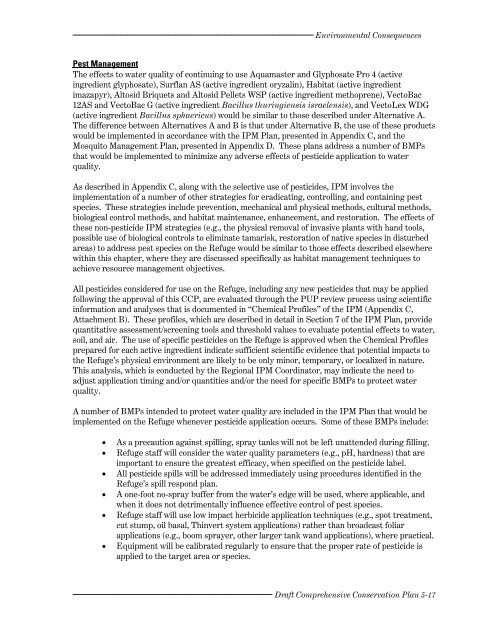Chapters 1 - U.S. Fish and Wildlife Service
Chapters 1 - U.S. Fish and Wildlife Service
Chapters 1 - U.S. Fish and Wildlife Service
Create successful ePaper yourself
Turn your PDF publications into a flip-book with our unique Google optimized e-Paper software.
Environmental Consequences<br />
Pest Management<br />
The effects to water quality of continuing to use Aquamaster <strong>and</strong> Glyphosate Pro 4 (active<br />
ingredient glyphosate), Surflan AS (active ingredient oryzalin), Habitat (active ingredient<br />
imazapyr), Altosid Briquets <strong>and</strong> Altosid Pellets WSP (active ingredient methoprene), VectoBac<br />
12AS <strong>and</strong> VectoBac G (active ingredient Bacillus thuringiensis israelensis), <strong>and</strong> VectoLex WDG<br />
(active ingredient Bacillus sphaericus) would be similar to those described under Alternative A.<br />
The difference between Alternatives A <strong>and</strong> B is that under Alternative B, the use of these products<br />
would be implemented in accordance with the IPM Plan, presented in Appendix C, <strong>and</strong> the<br />
Mosquito Management Plan, presented in Appendix D. These plans address a number of BMPs<br />
that would be implemented to minimize any adverse effects of pesticide application to water<br />
quality.<br />
As described in Appendix C, along with the selective use of pesticides, IPM involves the<br />
implementation of a number of other strategies for eradicating, controlling, <strong>and</strong> containing pest<br />
species. These strategies include prevention, mechanical <strong>and</strong> physical methods, cultural methods,<br />
biological control methods, <strong>and</strong> habitat maintenance, enhancement, <strong>and</strong> restoration. The effects of<br />
these non-pesticide IPM strategies (e.g., the physical removal of invasive plants with h<strong>and</strong> tools,<br />
possible use of biological controls to eliminate tamarisk, restoration of native species in disturbed<br />
areas) to address pest species on the Refuge would be similar to those effects described elsewhere<br />
within this chapter, where they are discussed specifically as habitat management techniques to<br />
achieve resource management objectives.<br />
All pesticides considered for use on the Refuge, including any new pesticides that may be applied<br />
following the approval of this CCP, are evaluated through the PUP review process using scientific<br />
information <strong>and</strong> analyses that is documented in “Chemical Profiles” of the IPM (Appendix C,<br />
Attachment B). These profiles, which are described in detail in Section 7 of the IPM Plan, provide<br />
quantitative assessment/screening tools <strong>and</strong> threshold values to evaluate potential effects to water,<br />
soil, <strong>and</strong> air. The use of specific pesticides on the Refuge is approved when the Chemical Profiles<br />
prepared for each active ingredient indicate sufficient scientific evidence that potential impacts to<br />
the Refuge’s physical environment are likely to be only minor, temporary, or localized in nature.<br />
This analysis, which is conducted by the Regional IPM Coordinator, may indicate the need to<br />
adjust application timing <strong>and</strong>/or quantities <strong>and</strong>/or the need for specific BMPs to protect water<br />
quality.<br />
A number of BMPs intended to protect water quality are included in the IPM Plan that would be<br />
implemented on the Refuge whenever pesticide application occurs. Some of these BMPs include:<br />
As a precaution against spilling, spray tanks will not be left unattended during filling.<br />
Refuge staff will consider the water quality parameters (e.g., pH, hardness) that are<br />
important to ensure the greatest efficacy, when specified on the pesticide label.<br />
All pesticide spills will be addressed immediately using procedures identified in the<br />
Refuge’s spill respond plan.<br />
A one-foot no-spray buffer from the water’s edge will be used, where applicable, <strong>and</strong><br />
when it does not detrimentally influence effective control of pest species.<br />
Refuge staff will use low impact herbicide application techniques (e.g., spot treatment,<br />
cut stump, oil basal, Thinvert system applications) rather than broadcast foliar<br />
applications (e.g., boom sprayer, other larger tank w<strong>and</strong> applications), where practical.<br />
Equipment will be calibrated regularly to ensure that the proper rate of pesticide is<br />
applied to the target area or species.<br />
Draft Comprehensive Conservation Plan 5-17

















